Management Accounting Report: Financial Planning, Budgeting, Variances
VerifiedAdded on 2021/05/31
|23
|4241
|267
Report
AI Summary
This report, prepared for the NSAB530B5 course, comprehensively examines management accounting principles and their application. It begins with a portfolio of calculations and commentary comparing absorption and marginal costing methods, highlighting their impact on reported profit or loss. The report then delves into budgetary planning tools, including budgets and variance analysis, discussing their advantages and disadvantages. It further explores the adoption of management accounting systems by organizations to address financial challenges, tracing the evolution of these systems from cost identification to strategic decision-making. The report emphasizes the use of management accounting for achieving sustainable success and provides insights into employing accounting planning tools to effectively resolve organizational financial issues. It covers a range of topics including sales, purchase, and cash flow budgets, and the importance of variance analysis in identifying and correcting deviations from planned performance, all supported by relevant references.
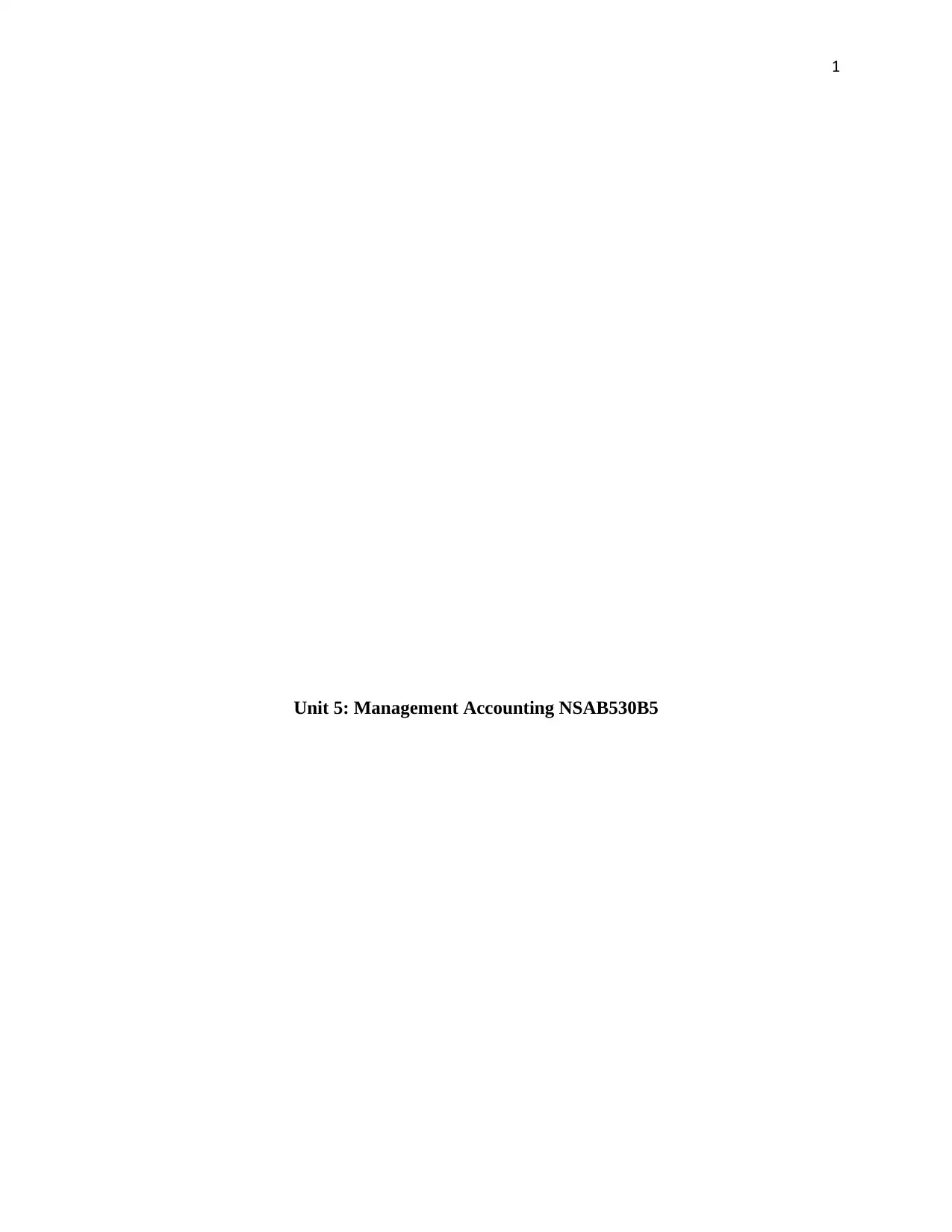
1
Unit 5: Management Accounting NSAB530B5
Unit 5: Management Accounting NSAB530B5
Paraphrase This Document
Need a fresh take? Get an instant paraphrase of this document with our AI Paraphraser
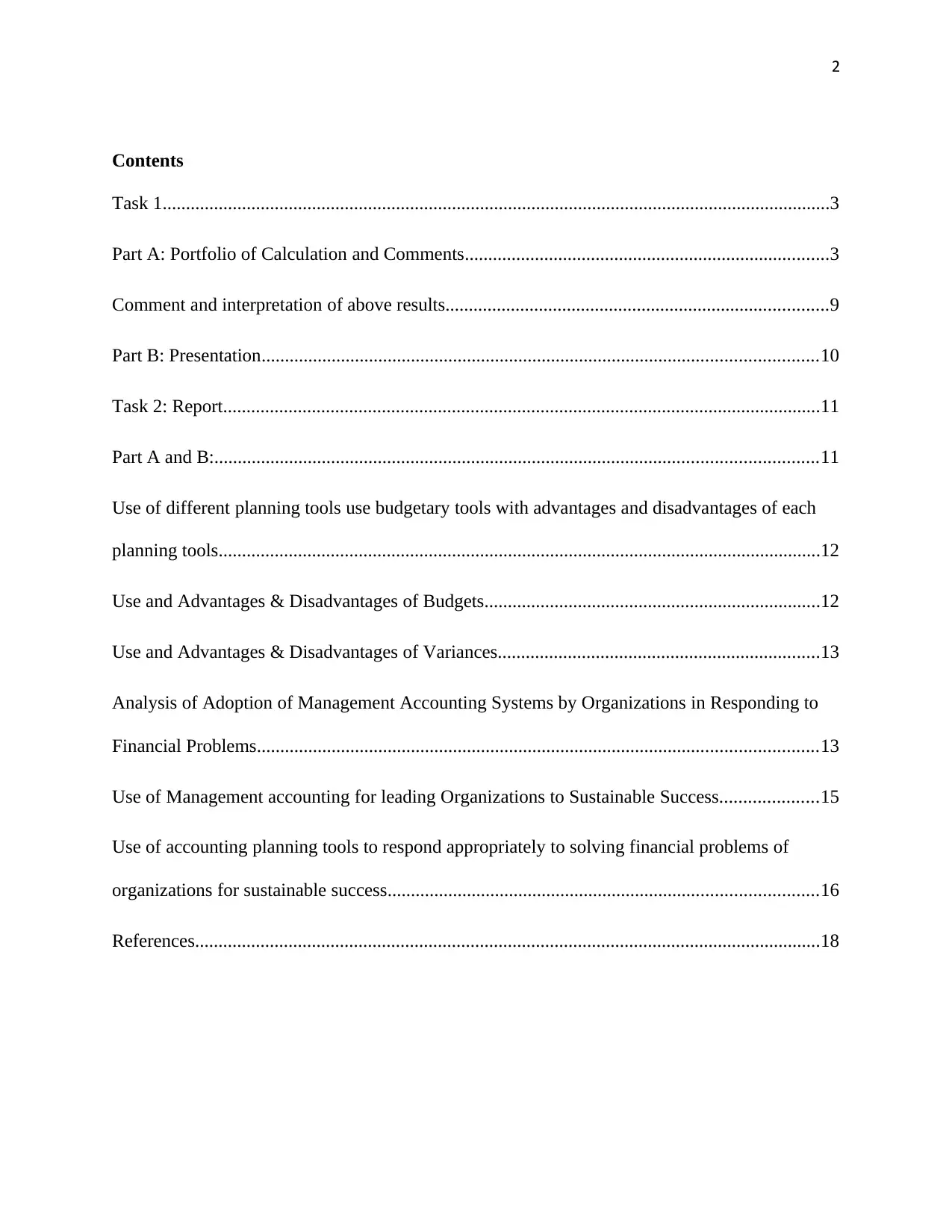
2
Contents
Task 1...............................................................................................................................................3
Part A: Portfolio of Calculation and Comments..............................................................................3
Comment and interpretation of above results..................................................................................9
Part B: Presentation.......................................................................................................................10
Task 2: Report................................................................................................................................11
Part A and B:.................................................................................................................................11
Use of different planning tools use budgetary tools with advantages and disadvantages of each
planning tools.................................................................................................................................12
Use and Advantages & Disadvantages of Budgets........................................................................12
Use and Advantages & Disadvantages of Variances.....................................................................13
Analysis of Adoption of Management Accounting Systems by Organizations in Responding to
Financial Problems........................................................................................................................13
Use of Management accounting for leading Organizations to Sustainable Success.....................15
Use of accounting planning tools to respond appropriately to solving financial problems of
organizations for sustainable success............................................................................................16
References......................................................................................................................................18
Contents
Task 1...............................................................................................................................................3
Part A: Portfolio of Calculation and Comments..............................................................................3
Comment and interpretation of above results..................................................................................9
Part B: Presentation.......................................................................................................................10
Task 2: Report................................................................................................................................11
Part A and B:.................................................................................................................................11
Use of different planning tools use budgetary tools with advantages and disadvantages of each
planning tools.................................................................................................................................12
Use and Advantages & Disadvantages of Budgets........................................................................12
Use and Advantages & Disadvantages of Variances.....................................................................13
Analysis of Adoption of Management Accounting Systems by Organizations in Responding to
Financial Problems........................................................................................................................13
Use of Management accounting for leading Organizations to Sustainable Success.....................15
Use of accounting planning tools to respond appropriately to solving financial problems of
organizations for sustainable success............................................................................................16
References......................................................................................................................................18
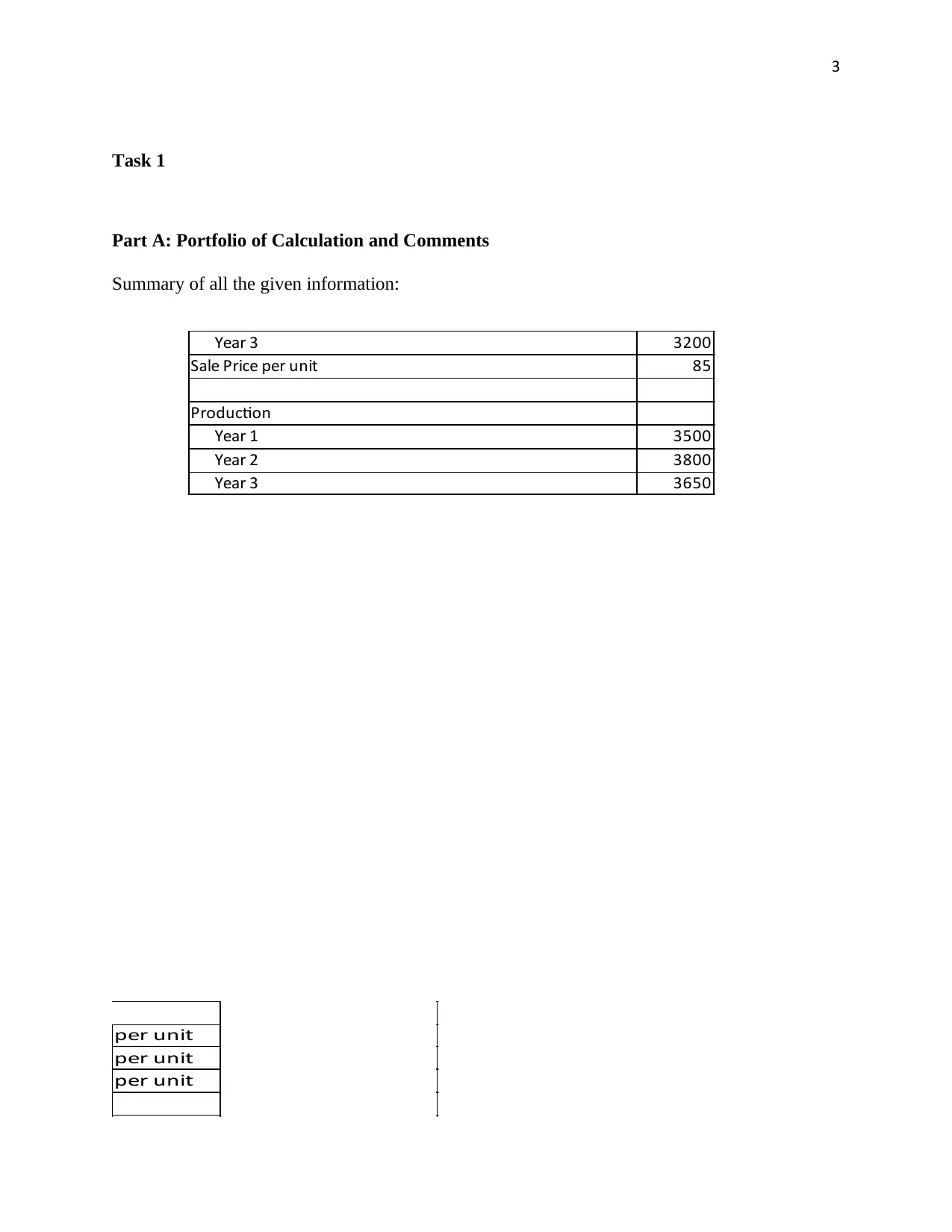
3
Task 1
Part A: Portfolio of Calculation and Comments
Summary of all the given information:
Year 3 3200
Sale Price per unit 85
Production
Year 1 3500
Year 2 3800
Year 3 3650
per unit
per unit
per unit
Task 1
Part A: Portfolio of Calculation and Comments
Summary of all the given information:
Year 3 3200
Sale Price per unit 85
Production
Year 1 3500
Year 2 3800
Year 3 3650
per unit
per unit
per unit
⊘ This is a preview!⊘
Do you want full access?
Subscribe today to unlock all pages.

Trusted by 1+ million students worldwide
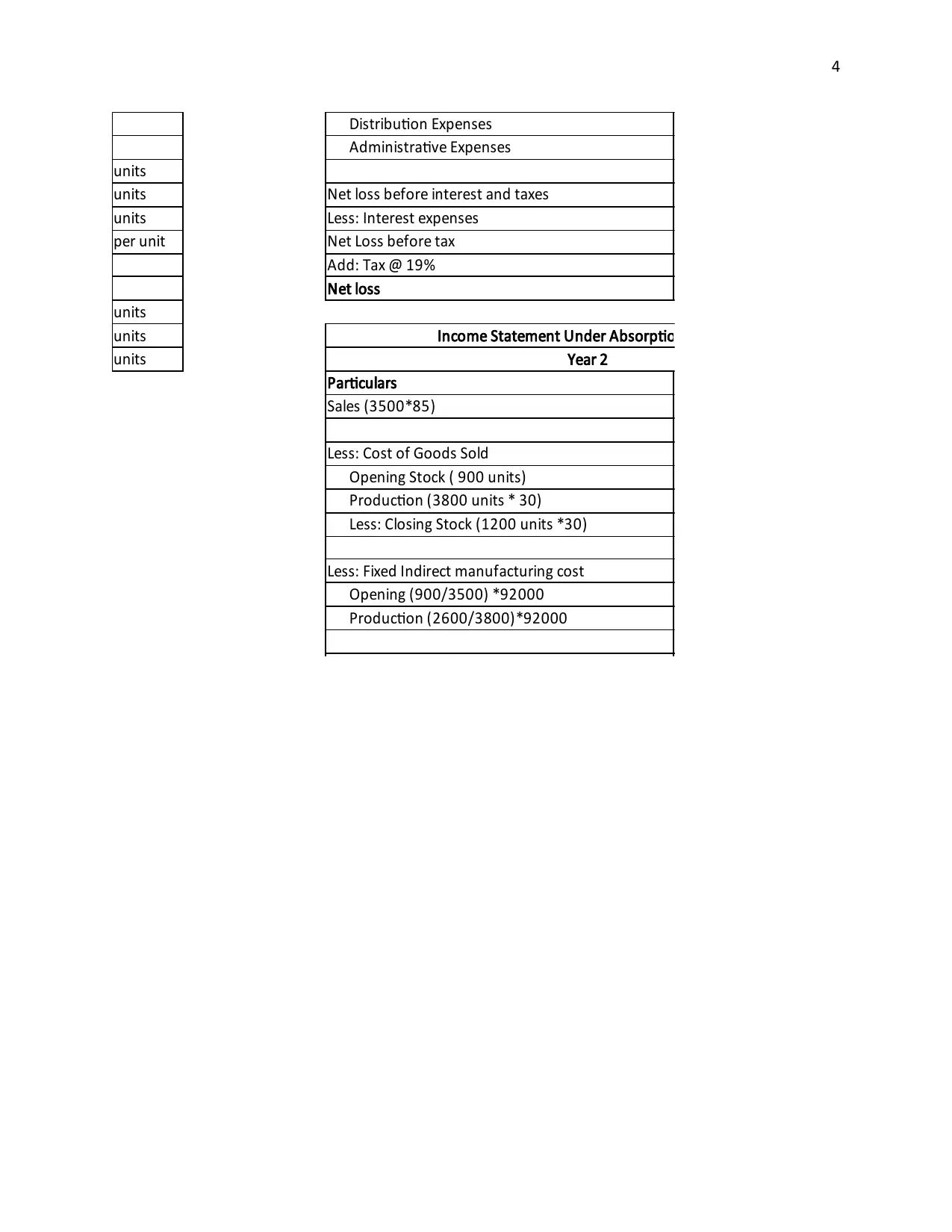
4
Distribution Expenses
Administrative Expenses
units
units Net loss before interest and taxes
units Less: Interest expenses
per unit Net Loss before tax
Add: Tax @ 19%
Net loss
units
units Income Statement Under Absorption Costing
units Year 2
Particulars
Sales (3500*85)
Less: Cost of Goods Sold
Opening Stock ( 900 units)
Production (3800 units * 30)
Less: Closing Stock (1200 units *30)
Less: Fixed Indirect manufacturing cost
Opening (900/3500) *92000
Production (2600/3800)*92000
Distribution Expenses
Administrative Expenses
units
units Net loss before interest and taxes
units Less: Interest expenses
per unit Net Loss before tax
Add: Tax @ 19%
Net loss
units
units Income Statement Under Absorption Costing
units Year 2
Particulars
Sales (3500*85)
Less: Cost of Goods Sold
Opening Stock ( 900 units)
Production (3800 units * 30)
Less: Closing Stock (1200 units *30)
Less: Fixed Indirect manufacturing cost
Opening (900/3500) *92000
Production (2600/3800)*92000
Paraphrase This Document
Need a fresh take? Get an instant paraphrase of this document with our AI Paraphraser
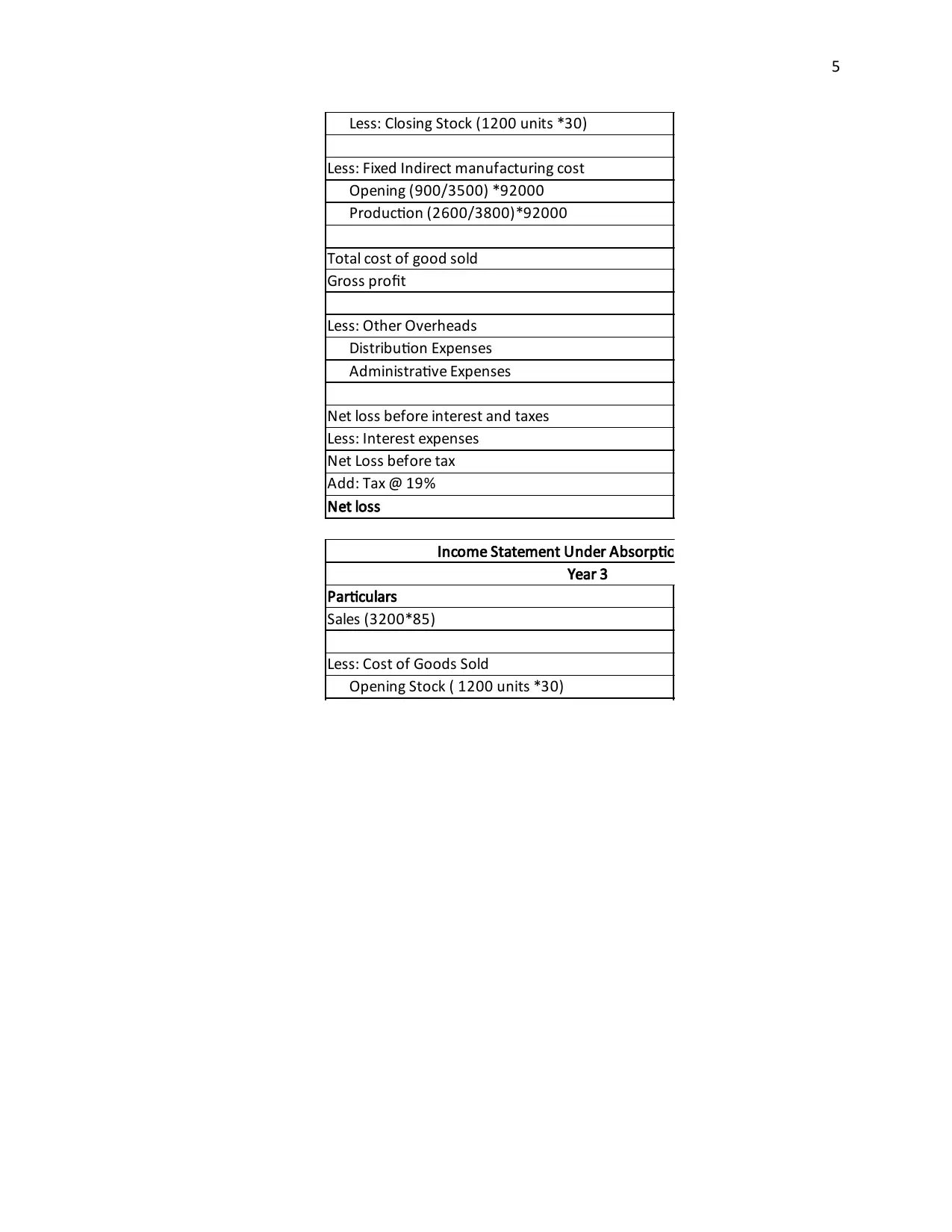
5
Less: Closing Stock (1200 units *30)
Less: Fixed Indirect manufacturing cost
Opening (900/3500) *92000
Production (2600/3800)*92000
Total cost of good sold
Gross profit
Less: Other Overheads
Distribution Expenses
Administrative Expenses
Net loss before interest and taxes
Less: Interest expenses
Net Loss before tax
Add: Tax @ 19%
Net loss
Income Statement Under Absorption Costing
Year 3
Particulars
Sales (3200*85)
Less: Cost of Goods Sold
Opening Stock ( 1200 units *30)
Less: Closing Stock (1200 units *30)
Less: Fixed Indirect manufacturing cost
Opening (900/3500) *92000
Production (2600/3800)*92000
Total cost of good sold
Gross profit
Less: Other Overheads
Distribution Expenses
Administrative Expenses
Net loss before interest and taxes
Less: Interest expenses
Net Loss before tax
Add: Tax @ 19%
Net loss
Income Statement Under Absorption Costing
Year 3
Particulars
Sales (3200*85)
Less: Cost of Goods Sold
Opening Stock ( 1200 units *30)
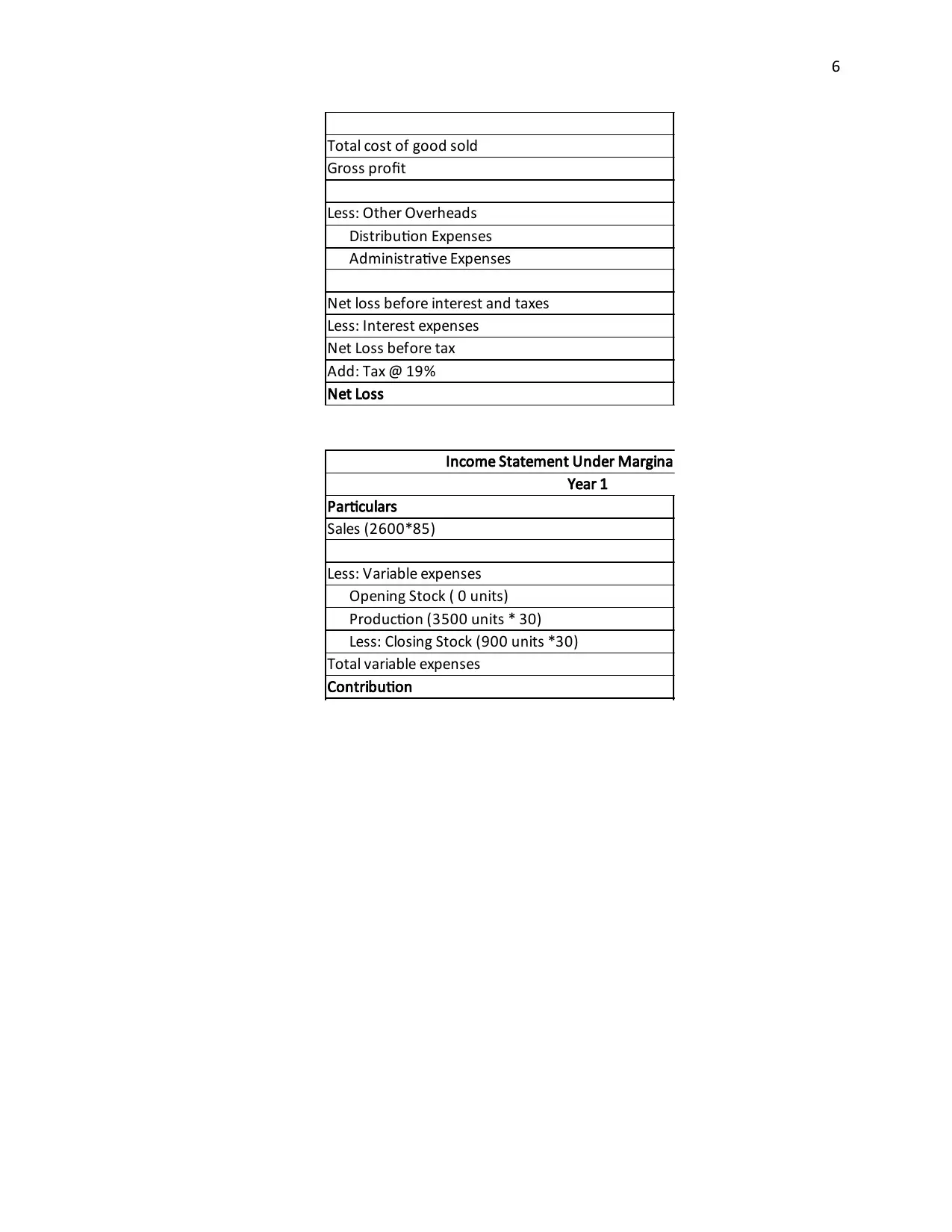
6
Total cost of good sold
Gross profit
Less: Other Overheads
Distribution Expenses
Administrative Expenses
Net loss before interest and taxes
Less: Interest expenses
Net Loss before tax
Add: Tax @ 19%
Net Loss
Income Statement Under Marginal Costing
Year 1
Particulars
Sales (2600*85)
Less: Variable expenses
Opening Stock ( 0 units)
Production (3500 units * 30)
Less: Closing Stock (900 units *30)
Total variable expenses
Contribution
Total cost of good sold
Gross profit
Less: Other Overheads
Distribution Expenses
Administrative Expenses
Net loss before interest and taxes
Less: Interest expenses
Net Loss before tax
Add: Tax @ 19%
Net Loss
Income Statement Under Marginal Costing
Year 1
Particulars
Sales (2600*85)
Less: Variable expenses
Opening Stock ( 0 units)
Production (3500 units * 30)
Less: Closing Stock (900 units *30)
Total variable expenses
Contribution
⊘ This is a preview!⊘
Do you want full access?
Subscribe today to unlock all pages.

Trusted by 1+ million students worldwide
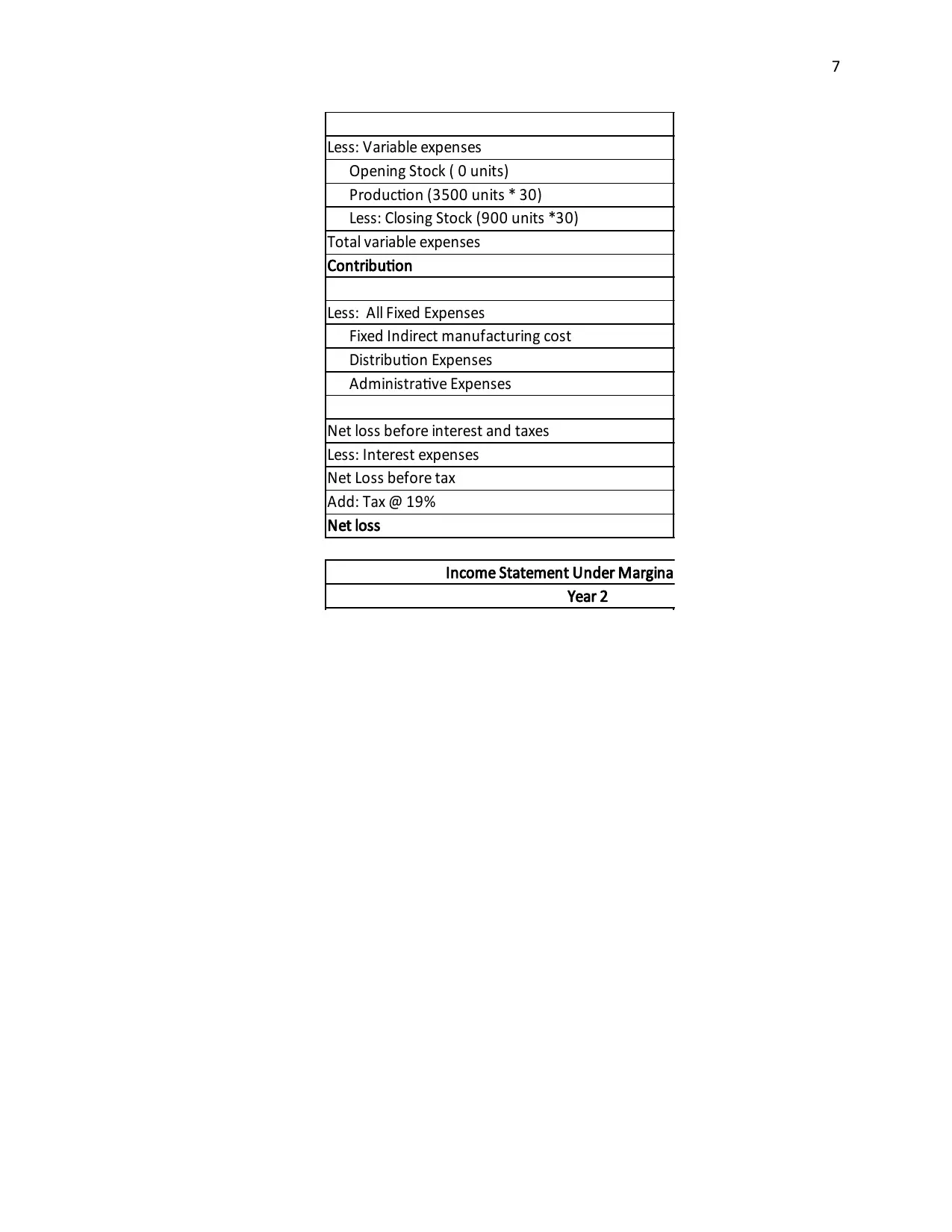
7
Less: Variable expenses
Opening Stock ( 0 units)
Production (3500 units * 30)
Less: Closing Stock (900 units *30)
Total variable expenses
Contribution
Less: All Fixed Expenses
Fixed Indirect manufacturing cost
Distribution Expenses
Administrative Expenses
Net loss before interest and taxes
Less: Interest expenses
Net Loss before tax
Add: Tax @ 19%
Net loss
Income Statement Under Marginal Costing
Year 2
Less: Variable expenses
Opening Stock ( 0 units)
Production (3500 units * 30)
Less: Closing Stock (900 units *30)
Total variable expenses
Contribution
Less: All Fixed Expenses
Fixed Indirect manufacturing cost
Distribution Expenses
Administrative Expenses
Net loss before interest and taxes
Less: Interest expenses
Net Loss before tax
Add: Tax @ 19%
Net loss
Income Statement Under Marginal Costing
Year 2
Paraphrase This Document
Need a fresh take? Get an instant paraphrase of this document with our AI Paraphraser
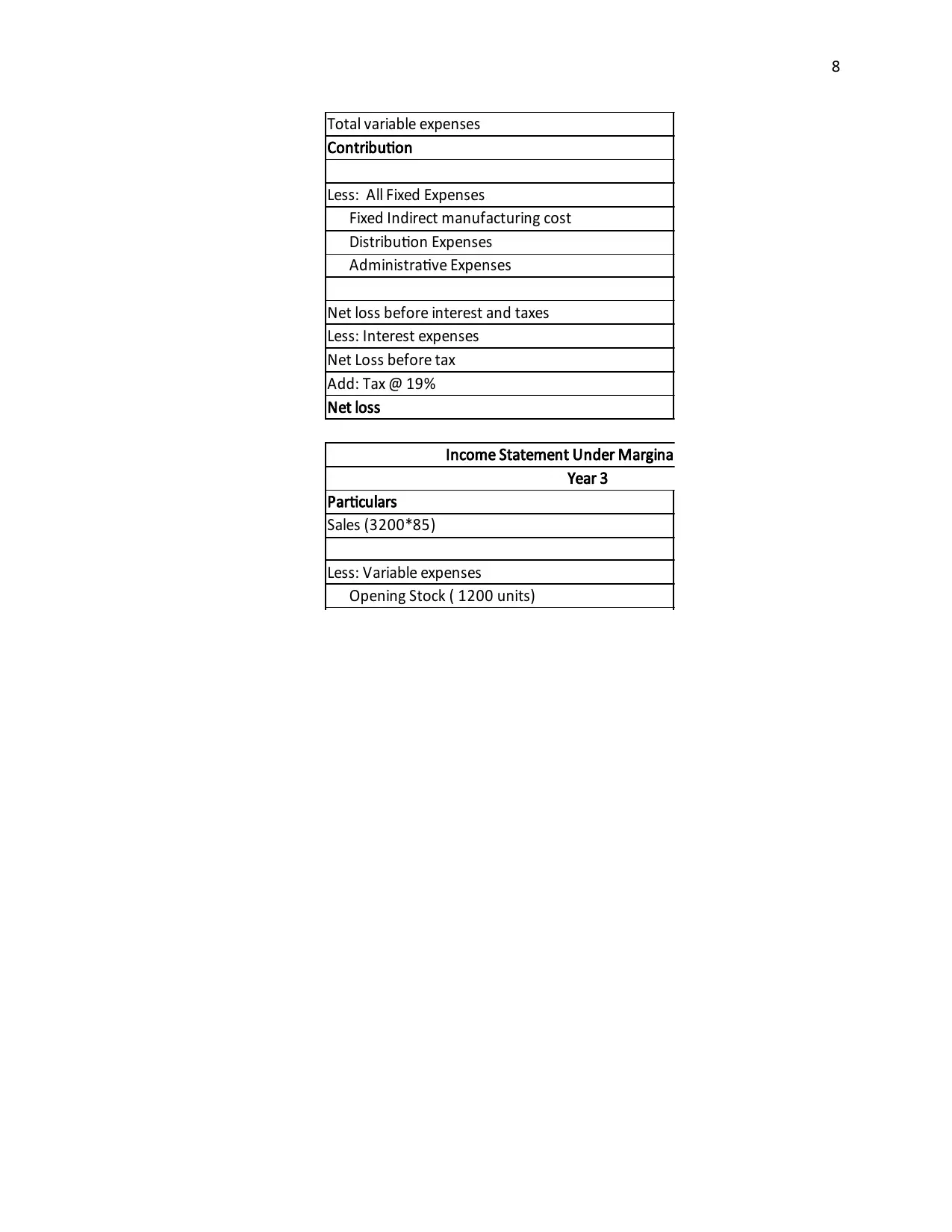
8
Total variable expenses
Contribution
Less: All Fixed Expenses
Fixed Indirect manufacturing cost
Distribution Expenses
Administrative Expenses
Net loss before interest and taxes
Less: Interest expenses
Net Loss before tax
Add: Tax @ 19%
Net loss
Income Statement Under Marginal Costing
Year 3
Particulars
Sales (3200*85)
Less: Variable expenses
Opening Stock ( 1200 units)
Total variable expenses
Contribution
Less: All Fixed Expenses
Fixed Indirect manufacturing cost
Distribution Expenses
Administrative Expenses
Net loss before interest and taxes
Less: Interest expenses
Net Loss before tax
Add: Tax @ 19%
Net loss
Income Statement Under Marginal Costing
Year 3
Particulars
Sales (3200*85)
Less: Variable expenses
Opening Stock ( 1200 units)
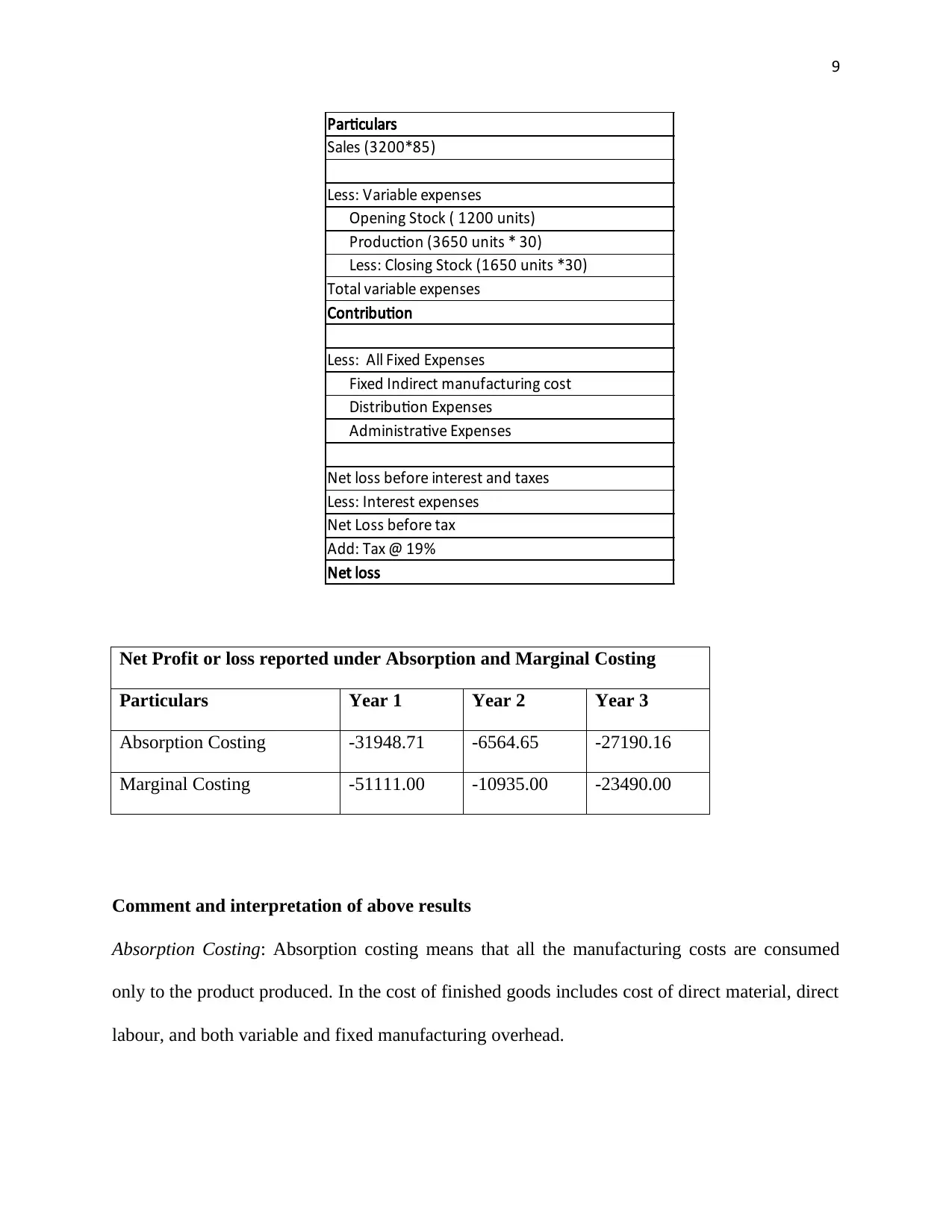
9
Particulars
Sales (3200*85)
Less: Variable expenses
Opening Stock ( 1200 units)
Production (3650 units * 30)
Less: Closing Stock (1650 units *30)
Total variable expenses
Contribution
Less: All Fixed Expenses
Fixed Indirect manufacturing cost
Distribution Expenses
Administrative Expenses
Net loss before interest and taxes
Less: Interest expenses
Net Loss before tax
Add: Tax @ 19%
Net loss
Net Profit or loss reported under Absorption and Marginal Costing
Particulars Year 1 Year 2 Year 3
Absorption Costing -31948.71 -6564.65 -27190.16
Marginal Costing -51111.00 -10935.00 -23490.00
Comment and interpretation of above results
Absorption Costing: Absorption costing means that all the manufacturing costs are consumed
only to the product produced. In the cost of finished goods includes cost of direct material, direct
labour, and both variable and fixed manufacturing overhead.
Particulars
Sales (3200*85)
Less: Variable expenses
Opening Stock ( 1200 units)
Production (3650 units * 30)
Less: Closing Stock (1650 units *30)
Total variable expenses
Contribution
Less: All Fixed Expenses
Fixed Indirect manufacturing cost
Distribution Expenses
Administrative Expenses
Net loss before interest and taxes
Less: Interest expenses
Net Loss before tax
Add: Tax @ 19%
Net loss
Net Profit or loss reported under Absorption and Marginal Costing
Particulars Year 1 Year 2 Year 3
Absorption Costing -31948.71 -6564.65 -27190.16
Marginal Costing -51111.00 -10935.00 -23490.00
Comment and interpretation of above results
Absorption Costing: Absorption costing means that all the manufacturing costs are consumed
only to the product produced. In the cost of finished goods includes cost of direct material, direct
labour, and both variable and fixed manufacturing overhead.
⊘ This is a preview!⊘
Do you want full access?
Subscribe today to unlock all pages.

Trusted by 1+ million students worldwide
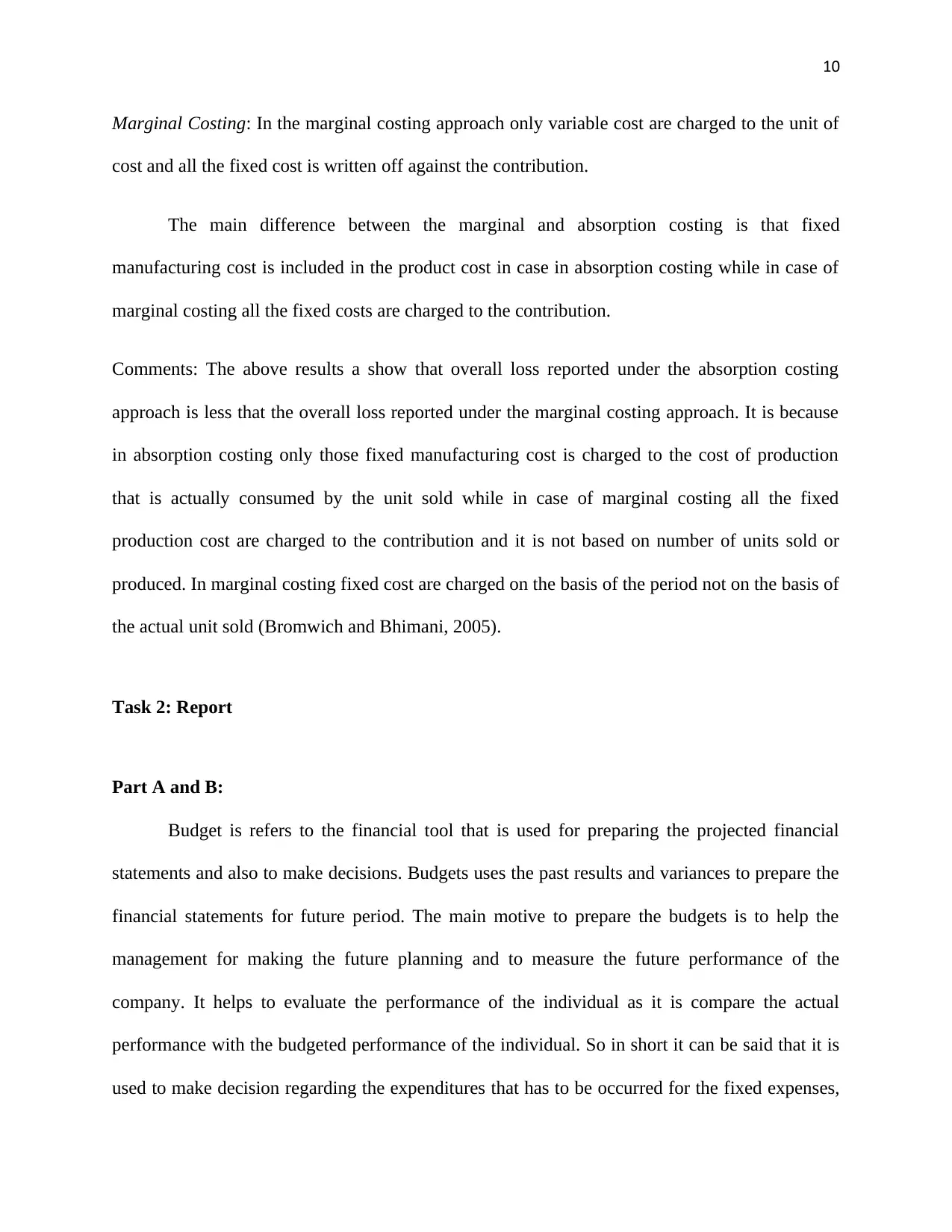
10
Marginal Costing: In the marginal costing approach only variable cost are charged to the unit of
cost and all the fixed cost is written off against the contribution.
The main difference between the marginal and absorption costing is that fixed
manufacturing cost is included in the product cost in case in absorption costing while in case of
marginal costing all the fixed costs are charged to the contribution.
Comments: The above results a show that overall loss reported under the absorption costing
approach is less that the overall loss reported under the marginal costing approach. It is because
in absorption costing only those fixed manufacturing cost is charged to the cost of production
that is actually consumed by the unit sold while in case of marginal costing all the fixed
production cost are charged to the contribution and it is not based on number of units sold or
produced. In marginal costing fixed cost are charged on the basis of the period not on the basis of
the actual unit sold (Bromwich and Bhimani, 2005).
Task 2: Report
Part A and B:
Budget is refers to the financial tool that is used for preparing the projected financial
statements and also to make decisions. Budgets uses the past results and variances to prepare the
financial statements for future period. The main motive to prepare the budgets is to help the
management for making the future planning and to measure the future performance of the
company. It helps to evaluate the performance of the individual as it is compare the actual
performance with the budgeted performance of the individual. So in short it can be said that it is
used to make decision regarding the expenditures that has to be occurred for the fixed expenses,
Marginal Costing: In the marginal costing approach only variable cost are charged to the unit of
cost and all the fixed cost is written off against the contribution.
The main difference between the marginal and absorption costing is that fixed
manufacturing cost is included in the product cost in case in absorption costing while in case of
marginal costing all the fixed costs are charged to the contribution.
Comments: The above results a show that overall loss reported under the absorption costing
approach is less that the overall loss reported under the marginal costing approach. It is because
in absorption costing only those fixed manufacturing cost is charged to the cost of production
that is actually consumed by the unit sold while in case of marginal costing all the fixed
production cost are charged to the contribution and it is not based on number of units sold or
produced. In marginal costing fixed cost are charged on the basis of the period not on the basis of
the actual unit sold (Bromwich and Bhimani, 2005).
Task 2: Report
Part A and B:
Budget is refers to the financial tool that is used for preparing the projected financial
statements and also to make decisions. Budgets uses the past results and variances to prepare the
financial statements for future period. The main motive to prepare the budgets is to help the
management for making the future planning and to measure the future performance of the
company. It helps to evaluate the performance of the individual as it is compare the actual
performance with the budgeted performance of the individual. So in short it can be said that it is
used to make decision regarding the expenditures that has to be occurred for the fixed expenses,
Paraphrase This Document
Need a fresh take? Get an instant paraphrase of this document with our AI Paraphraser
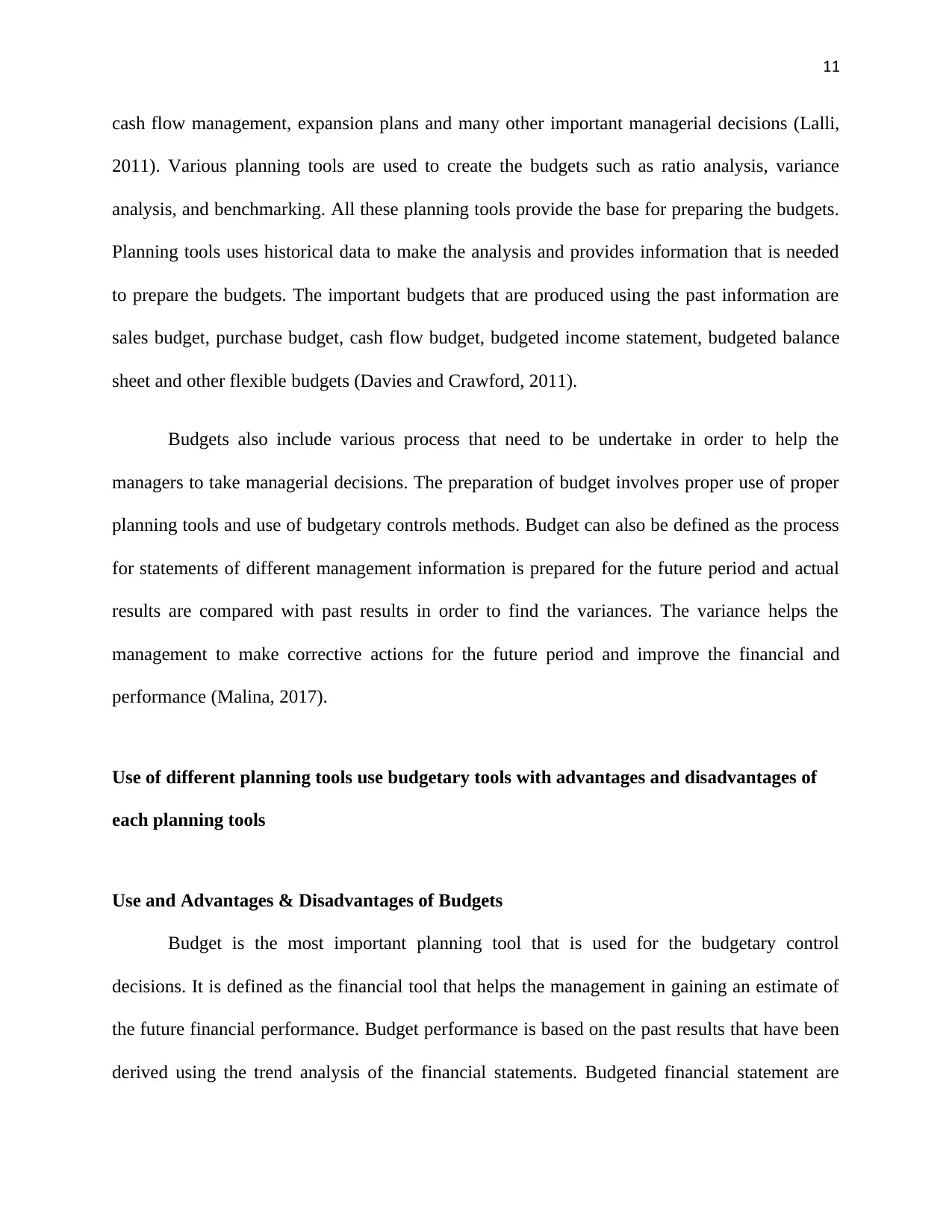
11
cash flow management, expansion plans and many other important managerial decisions (Lalli,
2011). Various planning tools are used to create the budgets such as ratio analysis, variance
analysis, and benchmarking. All these planning tools provide the base for preparing the budgets.
Planning tools uses historical data to make the analysis and provides information that is needed
to prepare the budgets. The important budgets that are produced using the past information are
sales budget, purchase budget, cash flow budget, budgeted income statement, budgeted balance
sheet and other flexible budgets (Davies and Crawford, 2011).
Budgets also include various process that need to be undertake in order to help the
managers to take managerial decisions. The preparation of budget involves proper use of proper
planning tools and use of budgetary controls methods. Budget can also be defined as the process
for statements of different management information is prepared for the future period and actual
results are compared with past results in order to find the variances. The variance helps the
management to make corrective actions for the future period and improve the financial and
performance (Malina, 2017).
Use of different planning tools use budgetary tools with advantages and disadvantages of
each planning tools
Use and Advantages & Disadvantages of Budgets
Budget is the most important planning tool that is used for the budgetary control
decisions. It is defined as the financial tool that helps the management in gaining an estimate of
the future financial performance. Budget performance is based on the past results that have been
derived using the trend analysis of the financial statements. Budgeted financial statement are
cash flow management, expansion plans and many other important managerial decisions (Lalli,
2011). Various planning tools are used to create the budgets such as ratio analysis, variance
analysis, and benchmarking. All these planning tools provide the base for preparing the budgets.
Planning tools uses historical data to make the analysis and provides information that is needed
to prepare the budgets. The important budgets that are produced using the past information are
sales budget, purchase budget, cash flow budget, budgeted income statement, budgeted balance
sheet and other flexible budgets (Davies and Crawford, 2011).
Budgets also include various process that need to be undertake in order to help the
managers to take managerial decisions. The preparation of budget involves proper use of proper
planning tools and use of budgetary controls methods. Budget can also be defined as the process
for statements of different management information is prepared for the future period and actual
results are compared with past results in order to find the variances. The variance helps the
management to make corrective actions for the future period and improve the financial and
performance (Malina, 2017).
Use of different planning tools use budgetary tools with advantages and disadvantages of
each planning tools
Use and Advantages & Disadvantages of Budgets
Budget is the most important planning tool that is used for the budgetary control
decisions. It is defined as the financial tool that helps the management in gaining an estimate of
the future financial performance. Budget performance is based on the past results that have been
derived using the trend analysis of the financial statements. Budgeted financial statement are
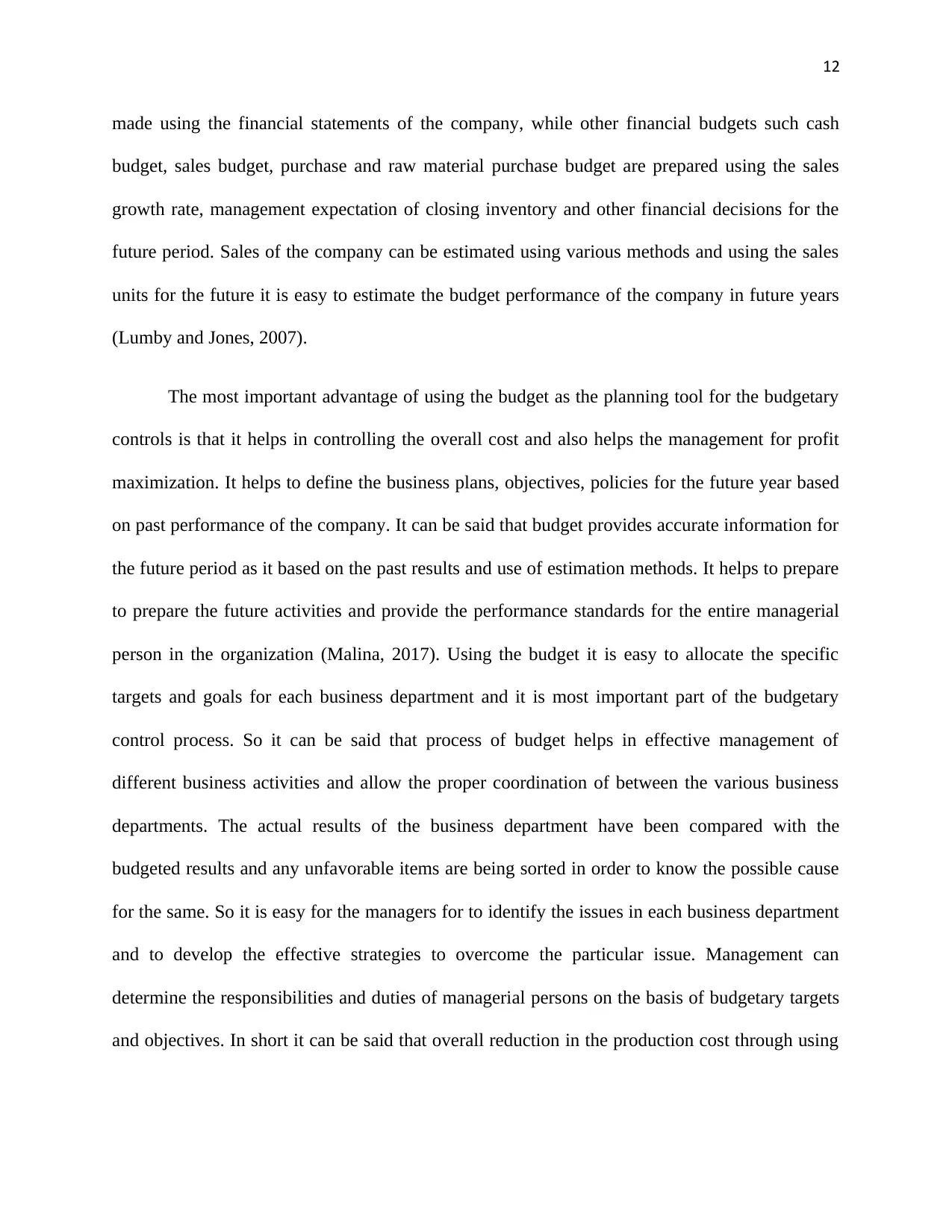
12
made using the financial statements of the company, while other financial budgets such cash
budget, sales budget, purchase and raw material purchase budget are prepared using the sales
growth rate, management expectation of closing inventory and other financial decisions for the
future period. Sales of the company can be estimated using various methods and using the sales
units for the future it is easy to estimate the budget performance of the company in future years
(Lumby and Jones, 2007).
The most important advantage of using the budget as the planning tool for the budgetary
controls is that it helps in controlling the overall cost and also helps the management for profit
maximization. It helps to define the business plans, objectives, policies for the future year based
on past performance of the company. It can be said that budget provides accurate information for
the future period as it based on the past results and use of estimation methods. It helps to prepare
to prepare the future activities and provide the performance standards for the entire managerial
person in the organization (Malina, 2017). Using the budget it is easy to allocate the specific
targets and goals for each business department and it is most important part of the budgetary
control process. So it can be said that process of budget helps in effective management of
different business activities and allow the proper coordination of between the various business
departments. The actual results of the business department have been compared with the
budgeted results and any unfavorable items are being sorted in order to know the possible cause
for the same. So it is easy for the managers for to identify the issues in each business department
and to develop the effective strategies to overcome the particular issue. Management can
determine the responsibilities and duties of managerial persons on the basis of budgetary targets
and objectives. In short it can be said that overall reduction in the production cost through using
made using the financial statements of the company, while other financial budgets such cash
budget, sales budget, purchase and raw material purchase budget are prepared using the sales
growth rate, management expectation of closing inventory and other financial decisions for the
future period. Sales of the company can be estimated using various methods and using the sales
units for the future it is easy to estimate the budget performance of the company in future years
(Lumby and Jones, 2007).
The most important advantage of using the budget as the planning tool for the budgetary
controls is that it helps in controlling the overall cost and also helps the management for profit
maximization. It helps to define the business plans, objectives, policies for the future year based
on past performance of the company. It can be said that budget provides accurate information for
the future period as it based on the past results and use of estimation methods. It helps to prepare
to prepare the future activities and provide the performance standards for the entire managerial
person in the organization (Malina, 2017). Using the budget it is easy to allocate the specific
targets and goals for each business department and it is most important part of the budgetary
control process. So it can be said that process of budget helps in effective management of
different business activities and allow the proper coordination of between the various business
departments. The actual results of the business department have been compared with the
budgeted results and any unfavorable items are being sorted in order to know the possible cause
for the same. So it is easy for the managers for to identify the issues in each business department
and to develop the effective strategies to overcome the particular issue. Management can
determine the responsibilities and duties of managerial persons on the basis of budgetary targets
and objectives. In short it can be said that overall reduction in the production cost through using
⊘ This is a preview!⊘
Do you want full access?
Subscribe today to unlock all pages.

Trusted by 1+ million students worldwide
1 out of 23
Related Documents
Your All-in-One AI-Powered Toolkit for Academic Success.
+13062052269
info@desklib.com
Available 24*7 on WhatsApp / Email
![[object Object]](/_next/static/media/star-bottom.7253800d.svg)
Unlock your academic potential
Copyright © 2020–2025 A2Z Services. All Rights Reserved. Developed and managed by ZUCOL.





